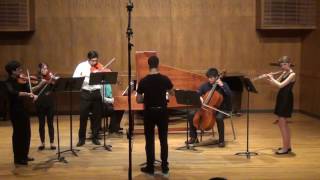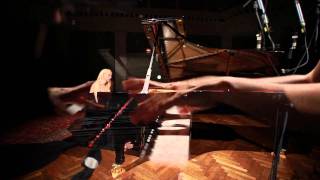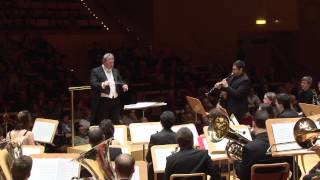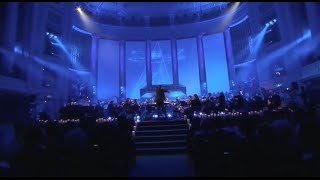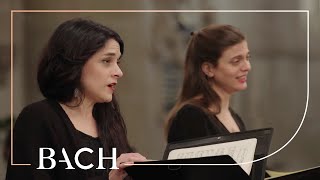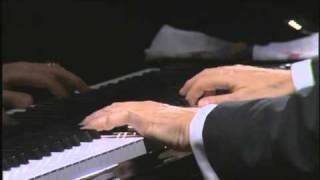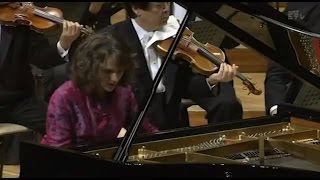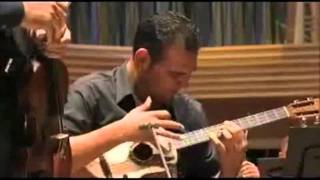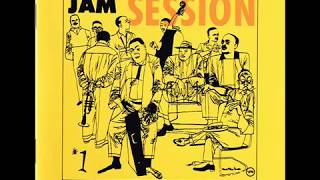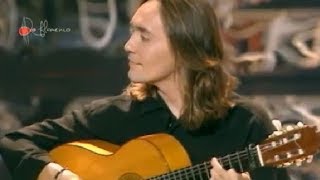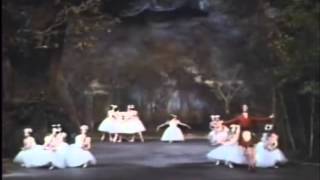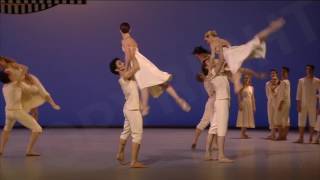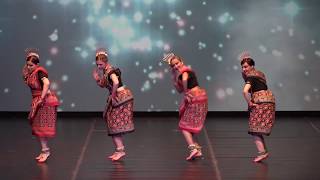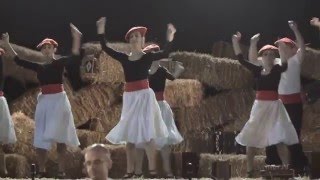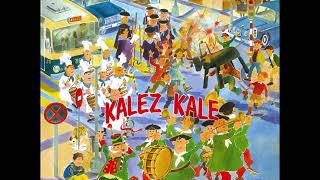Recommended music videos for initiation to classical music
Antonio Vivaldi (1678-1741) was an Italian priest, violinist and composer known as the red priest (“il prete rosso”). He was born in Venice and as a child he learned to play the violin with his father; At the age of 15 he entered the Seminary and once ordained a priest, he could barely attend to his religious obligations due to his health problems; So he was appointed violin teacher in an orphanage where he taught theory and instrument classes. At the age of 40 he was appointed Chapel Master in Mantua where he wrote his famous Four Seasons . From there he moved to Milan , then to Rome ; later, again to Venice and finally, to Vienna where he would die. Throughout his life he composed almost 800 works, of which half were concerts, 40 operas, 60 religious works and numerous sonatas.
Concerto for Flute in E Minor, RV 431. There is very little information on the Internet about this flute concerto. Kirsten Hall , our flute soloist, wrote this in an email about the piece: “As I looked up different Vivaldi recordings, I became more and more confused! On some recordings and in IMSLP (International Musical Score Library) it is labeled as the Concerto in E minor RV 431 . But in two other recordings (which are the same first and third movements), it is in D minor with a mysterious second movement, different in each recording!” ( Extracted from the foot of the video comment .) So today they only offer us the first (0'09') and the third movement (3'14'')
Frédéric Chopin (1810-1849) was a Polish virtuoso pianist and composer; As a pianist, he is considered one of the most important in history and as a composer, one of the leaders of Romanticism . He was born into a vocationally musical family; His mother played the piano and his father played the violin and flute; His first teacher was a sister of his with whom he liked to play four-hand pieces. At the age of eight he gave his first public concert at the Radziwill family palace in Warsaw . Chopin 's work focuses exclusively on the piano, solo or concertante, with which he undertook a solo career of technical perfection, expressive splendor and deepening of rubato until he became the musical reference for said instrument.
Frédéric Chopin's waltzes are medium-tempo pieces like common 3/4 waltzes, but they are noticeably different from Viennese waltzes, being performances for concert and not for dance. Some are accessible to pianists of moderate skill, but the most difficult ones require advanced technique.
Waltz L'adieu Opus 69 No. 1 . This waltz, composed in 1835, is the dedication to Chopin 's final farewell to the young Polish woman Maria Wodzinska , with whom he was engaged for two years. Today it is offered to us by the Ukrainian pianist residing in the USA Valentina Lisitsa.
Óscar Fernando Trujillo is a trumpeter and composer, with a degree in Music from the University of Caldas (Colombia). He has received training in Venezuela, Mexico, Puerto Rico and Brazil . He was a Mazda Foundation Scholar for Art and Science. His arrangements and compositions have been performed by groups such as the National Symphony Orchestra of Cuba, the Zaragoza Wind Ensamble, the Dominican Philharmonic Orchestra, the Salvador Youth Symphony Orchestra and the Caldas Symphony Orchestra . He is currently a trumpet professor at the University of Caldas , Principal Trumpeter of the Caldas Symphony Orchestra , Director and Founder of the Redemptorist Conservatory , Master of Music professor with an emphasis on trumpet at EAFIT University .
Wind Orchestra Zaragoza (WOZ). It began its journey in 2011 and is made up of 50 professional musicians. In these years he has performed twice in the Mozart room of the Zaragoza Auditorium in May 2012 and April 2013. He has two recordings to his credit, the CD “Spanish Winds” recorded at the Zaragoza Audio-visual Laboratory ; and the CD “Bestiarium” recorded in the Mozart Room of the Auditorium. She has collaborated in recordings for Aragón Televisión , in the Simón Awards gala for Aragonese cinema and has been invited to the “Ciudad de Valencia” International Music Band Competition . ( Extracted from the commentary of the Zaragoza Auditorium )
Frank de Vuyst was born in Zele (Flanders) in 1968 and began his musical studies at the Lokeren Academy , finishing a higher degree in music theory at the Ghent Conservatory . Later he moved to Maastricht where he graduated in saxophone with Norbert Nozy and in band conducting with Sef Pijpers . Later at the Tilburg Conservatory he obtained the “Docerend Musicus” degree in saxophone with Jean Pennings and the “Einddiploma” degree in Band Conducting with Jan Cober . In 1994 he worked as conductor with Richard Edlinger . His career has led him to direct the most important bands in Belgium, Holland, Portugal, Argentina, the United States, Colombia and Spain . Since November 2013 he has been artistic director of Wind Orchestra Zaragoza . ( Extracted from the commentary of the Zaragoza Auditorium )
Hans Zimmer (1957) is a German composer of soundtracks and video games. In 1988, the composition of the soundtrack for the film Rain Man earned his first Oscar nomination; From there he joined Hollywood doing various jobs and began to be known and recognized in specialist and popular environments. In 1994 he won his Oscar with the soundtrack of The Lion King and has been awarded with the Golden Globes, BAFTA, Emmy, Saturn and Grammy , to the point that he is known in his world as "the omnipresent Zimmer ", because His compositions appear on the most diverse occasions. Currently he is considered one of the most relevant composers of soundtracks.
The Da Vinci Code is a 2006 American mystery thriller film, written by Akiva Goldsman , based on Dan Brown 's 2003 novel of the same name, with music by Hans Zimmer and directed by Ron Howard . In the film, Robert Langdon , professor of religious symbology at Harvard University , is the prime suspect in the grisly and unusual murder of Louvre curator Jacques Saunière .
Today the ORF Radio Symphony Orchestra of Vienna conducted by Keith Lockhart offers us a suite from its soundtrack.
Recommended classical music videos
Johann Sebastian Bach (1685-1750) was a German violinist, organist, conductor and composer, born in Eisenach into the most prominent musical family in history. In 1703 he obtained his first job in Arndstat and in 1707 he moved to Mülhausen as an organist, where he married his cousin Maria Barbara with whom he had seven children. After the death of his wife in 1720, he remarried Mary Magdalene with whom he would have another thirteen children. In 1723 he moved to Leipzig where he would reside until his death at the age of 65. Considered one of the three main geniuses in the History of Music along with Mozart and Beethoven, his influence has been notable on Haydn , Mozart , Beethoven , Mendelssohn , Schumann , Chopin ... and many other renowned composers.
The Mass in B minor, BWV 232 is a sacred piece for soloists, choir and orchestra, written by Johann Sebastian Bach . The Mass is a compendium of many different styles in vocal composition, both in the Stile Antico that recalls Renaissance music (even containing Gregorian chant) and in the baroque concertante style of its time: writing and dances with fugues, arias and a movement for two choirs with four voices. Similar to the architecture of the time, Bach achieved a symmetry of parts, with the profession of faith ( Creed ) in the center and the Crucifixus at its center.
Excerpt from the bottom of the video : Sublime, extreme and all-encompassing... only superlatives serve to describe Bach 's Mass in B minor . Between a stunning Kyrie and the jubilant final Dona nobis pacem , there are nine completely unique arias and duets, fourteen impressive ensemble sections for four, five, six and even eight voices, a wide spectrum of instrumental solos and incredible variety. of styles.
Structure . 0:00 Kyrie eleison (Chorus) .-. 11:07 Christe eleison (Duetto) .-. 15:56 Kyrie eleison (Chorus) .-. 19:43 Gloria in excelsis Deo (Chorus).-. 21:25 Et in terra pax (Chorus).-. 26:06 Laudamus te (Aria) .-. 30:09 Gratias agimus tibi (Chorus) .-. 33:19 Domine Deus (Duetto) .-. 38:39 Qui tollis (Chorus).-. 41:39 Who are you (Aria) .-. 45:50 Quoniam tu solus sanctus (Aria).-. 50:33 Cum Sancto Spiritu (Chorus) .-. 54:14 Credo in unum Deum (Chorus).-. 56:13 Patrem omnipotentem (Chorus).-. 58:15 Et in unum Dominum (Duetto).-. 1:02:38 Et incarnatus est (Chorus).-. 1:05:52 Crucifixus (Chorus) .-. 1:08:58 Et resurrexit (Chorus).-. 1:12:56 Et in Spiritum Sanctum (Aria).-. 1:18:13 Confiteor (Chorus) .-. 1:22:18 Et exspecto (Chorus).-. 1:24:30 Sanctus (Chorus) .-. 1:26:58 Pleni sunt coeli (Concertante).-. 1:29:19 Hosanna in excelsis (Chorus).-. 1:31:59 Benedictus qui venit (Aria).-. 1:36:22 Hosanna in excelsis (Chorus).-. 1:39:05 Agnus Dei (Aria) .-. 1:45:17 Dona nobis pacem (Chorus)
Today's performance is offered to us by the sopranos Hana Blažíková and Anna Reinhold , the alto David Erler , the tenor Thomas Hobbs and the bass Peter Harvey accompanied by the Dutch Bach Society and all conducted by the also Dutch maestro Jos van Veldhoven .
Ludwig van Beethoven (1770-1827) together with Bach and Mozart is part of the trio of giants of Western music. Born in Bonn , his father, of Flemish origin, tried to showcase him as a second Mozart , although it was a notable failure. Despite this, from the age of nine the organist Christian Gottlob Neefe captivated him with the study of Bach , whom he would always keep in mind. In 1787 he moved to Vienna with the intention of taking Mozart classes, but the death of his mother returned him to Bonn a few days later. And so after five years, he returned to Vienna where he was able to study with Haydn and Salieri . However, his profession as an excellent pianist could not be carried out due to deafness that attacked him the following year, leaving him completely incapable of this faculty.
The Sonata was originally a composition written to be played or "sounded" by one or more musical instruments, as the cantata was to be "sung" by one or more voices. Beginning with classicism (1750-1810), its definition adjusts to a work generally structured in three movements (fast-slow-fast) and sometimes four, with or without a short introduction. It should not be confused with the sonata form , which is a compositional model.
The sonata for violin and piano No. 6 in A major, Op. 30 No. 1 Composed between 1801 and 1802, it consists of three movements: I (0´48´´) ALLEGRO. The first allegro movement is written in the key of A major, in 3/4 time and follows the sonata form (A: Exposition of the two main and contrasting themes, B: Development of both themes and C: Recapitulation of said themes with or without Coda). II (9´22´´) ADAGIO MOLTO ESPRESSIVO. The second movement is in D major, in 2/4 time and adopts a rondo form following the ABACA and coda pattern. The main theme or chorus of the rondo reappears three times, interspersed with two episodes each of which appears only once and all followed by a spellbinding coda. III (16'56'') ALLEGRETTO CON VARIAZIONI, The third and last movement, resumes the initial key, the rhythm is alla Brief and responds to the structure of the theme with variations; It is an original theme and six variations.
Today's version is offered to us by the famous duo made up of violinist Anne-Sophie Mutter and pianist Lambert Orkis
Johannes Brahms (1833-1897), born in Vienna , where he spent most of his life, was the composer of the most conservative romanticism compared to the progressive current led by Liszt and Wagner . His music is firmly rooted in the compositional structures and techniques of the classical masters and his formal structures faithfully follow the patterns of classicism, although he uses some of the color of romanticism and popular music. Eminently perfectionist in nature, he wrote for piano, chamber ensembles, symphony orchestra, for solo voices and for choir. It was Hans von Bulow who proposed the “three Bs” referring to Bach , Beethoven and Brahms as the three main pillars of the History of music .
The piano concerto No. 2 in B flat major, Op. 83, by Johannes Brahms is separated by about twenty years from his first piano concerto. It is considered by many pianists to be one of the most technically difficult pieces in piano literature. Unlike the first piano concerto, this one has four movements: I (0´32´´) ALLEGRO NON TROPPO .-. II (19´12´´) ALLEGRO APPASSIONATO .-. III (28´30´´) ANDANTE .- . IV (40´10´´) ALLEGRETTO GRAZIOSO. In this work, Brahms , following Liszt's example, alters the traditional scheme of the classical concerto, introducing, after the first movement, a fast second movement. The piece was premiered in Budapest on November 9, 1881 with the composer at the piano.
The French pianist Hélène Grimaud (1969) is one of the most outstanding performers of her generation. He descends from a family with different cultural heritage: on his father's side he has the Sephardic branch of North Africa , and on his mother's side, he has Jews from Corsica . His family changed their surname (from Grimaldi to Grimaud) before he was born. At the age of seven he discovered the piano and began his training with Jacques Rouvier . He studied at the Marseille Conservatory and the Paris Conservatory. In 1987 he began his career as a soloist, in a recital with the Paris Orchestra conducted by Daniel Barenboim ; From this moment on he participates in numerous festivals and concerts around the world playing with the best conductors and orchestras.
Aldemaro Romero (1928 - 2007) was a Venezuelan musician, composer, arranger and conductor. He began his musical studies with his father. In 1942, the family moved to Caracas and began playing in nightclubs, while, in parallel, he took music classes with the Venezuelan composer Moisés Moleiro and later with Luis Alfonzo Larrain , who introduced him to his orchestra. In 1948, he created his own dance orchestra, making different contracts and recordings of different types in New York , Venezuela, and England until in 1979 he founded the Caracas Philharmonic Orchestra. In his vast musical production, a large number of concerts for string instruments, wind, keyboard and percussion and choral groups stand out.
La Fuga con Pajarillo by composer and pianist Aldemaro Romero is an arrangement by the author of the first movement of Suite No. 1 for Strings ; In it he mixes popular songs and folkloric elements with classical forms and techniques . Maestro Dudamel says: "A pajarillo is a typical Venezuelan dance, perhaps the most famous, along with the joropo; it is like a waltz, but with the accent on the weak rhythm. The present piece is a bird, but in combination with a complex fuga [imitative musical form]. The little bird that permeates the melody and rhythm gives a sense of improvisation and contrasts with the default fugal form. This is what makes this piece so fascinating." (Extracted from the article published in La Phil ).
Today's performance is by violinist Alexis Cárdenas and his Ensemble accompanied by the Simón Bolívar Youth Symphony Orchestra conducted by maestro Gustavo Dudamel (1981), Venezuelan conductor, who trained in within the System of Youth and Children's Orchestras of Venezuela where he began at the age of four and where he studied violin, composition and orchestra conducting. Despite his youth, he has conducted the main orchestras in the world and is considered one of the most important conductors of the moment. He is currently the head of the Los Angeles Philharmonic Orchestra and the Simón Bolívar Symphony Orchestra .
Recommended music videos for all tastes
Charlie Parker (1920 – 1955) was an American jazz saxophonist and composer. He is considered one of the best alto saxophone players in the history of that musical genre, being one of the key figures in its evolution and one of its most legendary and admired artists along with Louis Armstrong, Duke Ellington, John Coltrane and Miles Davis. Along with Bud Powell, Dizzy Gillespie and others, he is one of the initiators of bebop . His style breaks with that of swing and is based on improvisation on a melody, modifying the chords and thus creating new variations on the structure of the songs; He is also the creator of new songs that have become jazz standards such as: "Ornithology", "Anthropology", "Scrapple from the Apple", "Ko Ko", "Now's the Time" and "Parker's Mood ".
A Jam Session is an informal musical improvisation meeting. The classic definition of a jam session is due to George Frazier : "An informal gathering of jazz musicians, with temperamental affinity, who play for their own enjoyment of unwritten or rehearsed music." In its origins, the jam session was a meeting highly competitive; It acquired, according to Peter Clayton and P. Gammond , the atmosphere of a "gladiator combat" when two or more players of the same instrument came together. Likewise, according to the same authors, the term jam was sometimes used as a synonym for jazz . Over time, the concept has ended up being applied to genres other than jazz , especially blues, rock, rap , and even music of folkloric origin such as Irish and bluegrass .
Taylor Swift (1989) is an American singer and actress born in Reading ( Pennsylvania ), who at the age of 14 moved to Nashville ( Tennessee ) to dedicate herself to the study of country music . At the age of 17 he released his first album and two years later he received a nomination for the Grammy Awards. That same year he released a new album, Fearless , which would be the best-selling in the USA , due to songs like Love Story and You Belong with Me , and with which he would win four Grammy Awards. In 2012 his single, We Are Never Ever Getting Back Together , became number 1 on the Billboard Hot 100 list. In 2014 his Shake It Off , was again number 1 on the Billboard Hot 100 list, unseated to fourth place. week for another album of his , Blank Space ; Thus she has continued her career to become one of the artists who has sold the most albums in history.
Vicente Amigo (1967) is a flamenco guitarist born in Guadalcanal (Seville) and one of the most recognized “tocaores”. At the age of eight he was given his first guitar, but his career did not begin until he was 21 at the Minas de la Unión Festival ; The following year he won the Extremadura International Competition and the Ramón Montoya Prize ; In 1999 he was awarded the Music Prize for “Best Flamenco Artist” and “Best Flamenco Composer”. His albums have earned important recognition and his tours have been lavish all over the world. The video we present today, La Ciudad de las Ideas , won the Grammy for Best Flamenco Album in 2001 and the following year, the Ondas Award .
Ana Gabriel (1955), is a Mexican singer-songwriter and businesswoman, called the Diva of America and the Moon of America . She has 49 years of experience with popular songs of her own such as "Simply Amigos", "Quien como tu" and " I don't need you ." She is the daughter of Ramón Araujo Valenzuela and Isabel Yong , her mother being of Chinese descent. He has received 13 Lo Nuestro, Billboard and Latin Grammy awards, among others. Likewise, she is the winner of several diamond records, gold records and platinum records. He has recorded as a duet with artists such as Armando Manzanero, Pedro Fernández, Yuri, Plácido Domingo, José Feliciano, Jon Secada, Rocío Jurado, Vicky Carr, Vicente Fernández, Juan Gabriel, Albita, Marc Antony, José Luis Perales among others.
Recommended peculiar videos
Jean Schneitzhoeffer (Toulouse, October 13, 1785 - Paris, October 4, 1852) was a French composer and pianist. He was a student of Charles Simon Catel at the Paris Conservatory . In 1803, at the age of 17, he won second prize in piano. According to artist Charles Seshan , "he played almost all instruments and was a gifted pianist." In 1815 he obtained the position of cymbalist at the Paris Opera. In 1822 he was appointed chef de chant ('vocal coach'). He was appointed professor in the choir classes of the Paris Conservatory . In 1840 he was awarded the Legion of Honor .
La Sylphide is a romantic ballet in two acts, choreographed by Filippo Taglioni in 1832 and there is a second version choreographed by Auguste Bournonville in 1836. Bournonville 's version is the only one that has survived and is one of the oldest ballets in the world. Its script tells us the adventures of the young Scot, James , engaged to Effie , who falls in love with a Sylph , an ethereal creature invisible to the rest of humans. Today we offer the choreographic version by Pierre Lacotte , based on the original by Filippo Taglioni with music by Jean Schneitzhoffer and performed by Ghislaine Thesmar (la Sylphide), Michael Denard (James) and Laurence Nerval (Effie)
Maurice Ravel (1875-1937), born in Ziburu/Ciboure (Basque Country in France), inherited his meticulous work from his father, an engineer of Swiss origin, and his passion for music from his mother, born in Mendata (Bizkaia). with the folk songs with which he adorned his childhood. A few months after he was born, the family moved to Paris , where at the age of six he began his piano studies. At the age of 14 he entered the Paris Conservatory where he had the opportunity to study with Gabriel Fauré . In 1901 he premiered his Jeux d'eau , a piano work with which he began to make his way in the musical circles of Paris where the influence of Ravel on Debussy and vice versa was discussed. In 1921 he lived until his death in a mansion near Paris , where eminent musicians and intellectuals met.
Daphnis and Chloe is a ballet set to music by Maurice Ravel , who described it as a symphonie choréographique ("choreographic symphony"). The script was adapted by Michel Fokine from a novel of the same title by the Greek writer Longo (end of the 2nd century - beginning of the 3rd century AD). It is about the discovery of love by two young people, a goatherd and a shepherdess, who after various adventures (presence of an admirer of Chloe , Dorcón , and a prostitute who tempts Daphnis , Liceion ; kidnapping of Chloe by pirates. ..), a happy ending occurs with the wedding of the protagonists. Ravel began working on the score in 1909 at the request of Sergei Diaghilev . The ballet premiered at the Théâtre du Châtelet in Paris by the Ballets Russes on June 8, 1912.
Today, choreographed by Frederick Ashton , The Royal Ballet offers us the first of the nine parts into which the viewing of the work is divided.
Sambalpur , in Orissa, India, is a region that has a distinct cultural identity. The songs, clothes, dances, language and festivals celebrated in Sambalpur are unique. This distinct cultural identity arises from the strong association of tribal and folk communities that have been co-existing in Sambalpur for centuries.
Today we present this Sambalpuri Folk Dance , performed by the dance project “ Odissi with Elena Knyazeva ” and Polina Lavrushkina ’s “ Srishti ” group.
The folk music band Korrontz i (Basque Country, 2004) was formed by trikitilari (trikitixa performer: Basque diatonic accordion) Agus Barandiaran . His objective, when forming the band, was fundamentally to give Basque popular music, as well as the ancestral and traditional sounds of his land, a more modern and contemporary aspect, but always from the perspective of music based on trikitixa . and other traditional instruments such as the txalaparta or the alboka , without ever forgetting the absolute respect for all the tradition that he had received from his first teacher, the trikitilari Rufino Arrola (1909 – 1996).
During these years, Korrontzi has taken his culture, language, dance and music around the world, playing at large festivals and visiting numerous countries, such as Belgium, USA, Romania, Cape Verde, Ireland, Brazil, Malaysia, Scotland, Holland, Greece , Italy, Canada, Hungary, Portugal, England, Cyprus, Morocco, Germany, Croatia, Slovenia, Austria, Czech Republic... and has been awarded with awards and mentions such as the " World Music Charts " in 2014, 2015, 2016 and 2019, « Top100 Roots Music Report (2015)», « Womex Official Selection (2014)», « Best European band, Eurofolk (2009)», « Best band from the peninsula, Navelgas (2007)»,...
Recommended music videos for children
Various Wikipedia articles have been used to write these texts.
The texts of Videomusicalis are written in Basque, Spanish and English.





